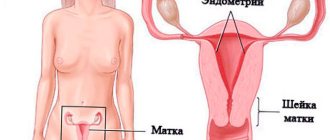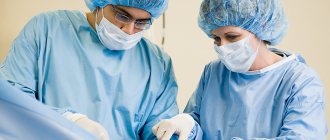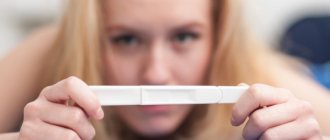What is hysteroscopy
Hysteroscopy as a diagnostic method is often used in gynecology. Thanks to it, you can assess the condition of the uterine cavity, detect the presence of inflammation, tumors and various gynecological diseases. This is an invasive type of surgical intervention, during which an experienced gynecologist inserts a special optical device, a hysteroscope, with a camera at the end, into the uterine cavity through the external genitalia. The image from the camera appears on the computer screen. To avoid postoperative complications, it is important that the surgical procedure is performed by a doctor with certain skills.
Hysteroscopy is usually done on days 6-10 of the menstrual cycle. Since a woman may experience some discomfort and pain during the operation, it is performed under general anesthesia. If the procedure is performed for diagnostic rather than therapeutic purposes, it can be performed with local anesthesia. The duration of the operation is 10-30 minutes, depending on the skills of the doctor and the general condition of the patient. After a diagnostic intervention, the recovery period is about 3 days, and after a therapeutic operation - about 3 weeks.
There are several types of hysteroscopy:
- microhysteroscopy. The condition of the uterus is assessed at the cellular level, the organ is not injured;
- diagnostic procedure. Based on the results of the intervention, it is possible to establish the presence of diseases, tumors and inflammations in the uterus. The organ is not damaged;
- hysteroresectoscopy. During this operation, small tumors are eliminated, a low-traumatic intervention under local anesthesia;
- diagnostic curettage. Used to eliminate polyps and fibroids. Surgical method requiring general anesthesia;
- control hysteroscopy is performed to check the effectiveness of treatment and for the timely detection of possible complications.
Since the introduction of a foreign body, which is what a hysteroscope is, into the uterine cavity in any case is a traumatic procedure for the body, it is quite natural that after it, spotting, scanty red discharge from the vagina and weak nagging pain in the lower abdomen may occur. In cases where there is heavy blood loss after diagnostic hysteroscopy, you should immediately seek help from a specialist. A large amount of bloody discharge that lasts for a short time is acceptable after curettage.
On what day of the cycle is hysteroscopy of the uterus performed?
In cases where hysteroscopy is performed routinely and not urgently, the doctor sets a date taking into account the day of menstruation. The time of the procedure is selected taking into account the indications. If adenomyosis, endometriosis, or the presence of submucous fibroids are suspected, it is best to perform the manipulation immediately after menstruation. The optimal period for carrying it out is the 7th day of the cycle - at this time the bleeding has already ended, and the endometrium has not yet had time to grow. It is advisable to plan the manipulation for 6-11 days from the start of menstruation.
If the procedure is necessary to assess the condition of the endometrium, remove polyps, or find out the causes of infertility, then it is best to do it after ovulation.
Is it possible to do hysteroscopy during menstruation?
In emergency cases, when it is necessary to immediately obtain data on the condition of the endometrium and the uterine cavity, it is possible to perform hysteroscopy during menstruation. Bleeding is not a contraindication, but sloughing off parts of the endometrium and blood impair visibility, so the effectiveness of the procedure is reduced.
Theoretically, the study is possible, but in practice, doctors try to wait until the end of menstruation. If a woman has bleeding of unknown etiology, then the examination is carried out without waiting for its completion.
Hysteroscopy before menstruation
In the second half of the cycle, before menstruation, hysteroscopy is prescribed in cases where the patient needs to undergo separate diagnostic curettage. This is a minimally invasive procedure that is performed under the supervision of a physician. The doctor does not act by touch, as during conventional curettage, but controls the entire process through a video camera.
Comment! It is better to remove polyps before menstruation, when the endometrium is at its maximum thickness.
Is it possible to do hysteroscopy during menstruation?
Hysteroscopy is prescribed at the time when it is easiest to examine the uterine cavity using an optical instrument. Usually this period occurs on the last day of regulation. But there are situations when intervention needs to be done urgently, then menstruation is not an obstacle to the operation. During menstruation, it is better to do it on the very first day, when the discharge is not too intense, and the growth of the endometrium has just begun. The final decision on the date of the operation is made by the attending physician, who selects the best moment for himself, when the structure of the patient’s uterine cavity will be as accessible as possible for visualization.
If the procedure is prescribed to women suffering from various gynecological disorders during menopause, when their menstrual function is already completed, hysteroscopy can be performed on any day.
The nature of menstruation after the procedure
A woman should pay attention to the nature of menstruation after hysteroscopy
Many patients who have undergone surgery note that some time after the operation they have very heavy periods. Their duration also changes; the first menstruation after the intervention will be longer than before. It’s hard to say when your next period will start and how long it will take for the cycle to recover.
Let's take it in order. How to determine how big the problem is? Pay attention to how often you have to change the gasket. If the discharge is too heavy - more than once every 3-4 hours. Then you should seek advice from your doctor, who will tell you what to do. You also need to pay attention to whether there is a need to change hygiene products at night. If a woman is concerned about the length of her period, which brings her discomfort, then she should definitely seek medical help. Excessive amounts of menstrual blood can cause weakness and will greatly interfere with life.
What is the volume of menstruation and whether its quantity changes is very important. It is not uncommon to have scanty periods after hysteroscopy. This may be due to the fact that sometimes after surgery the pattern of menstruation is reversed. That is, if before they were abundant, now they will be scarce and last less, or vice versa.
The structure of the discharge may change. This means that clots appear, the color of the discharge and the smell change. Changes begin immediately after hysteroscopy. Menstruation with clots can be directly related to the postoperative period when blood is released. Women note that menstruation in this case began earlier than expected. An unpleasant odor may indicate an infection. There is no need to even explain how dangerous this is. The infectious process can affect not only the genitals, but also go further and become generalized.
Gynecologist prescribes treatment
Any changes in the nature of menstruation should alert a woman and force her to seek help!
Brown menstruation after hysteroscopy may indicate endometriosis. If menstruation occurs prematurely, before the expected period, this is most likely postoperative discharge.
Menstruation after hysteroscopy may be painful. The fact is that surgery, especially with resection of tumors, is a damaging factor for the uterine mucosa. She needs time to heal and restore full functioning. This period is accompanied by pain. There is virtually no chance that they will remain forever.
In what cases is the menstrual cycle disrupted?
Cycle disruption is one of the possible consequences of any surgical intervention. Menstruation after hysteroscopy may also occur with disruptions, since during the operation the integrity of the inner layer of the uterus may be damaged. The menstrual cycle may be disrupted for other reasons:
- During the procedure, an infection entered the reproductive system. This is a common situation when hysteroscopy and laparoscopy are performed together;
- if the endometrium has become thinner during the procedure;
- dysfunction can be caused by stress experienced by a woman, because any operation is an additional psycho-emotional burden for a person;
- The hormonal balance may be disrupted; it simply takes time to normalize it; in especially severe cases, hormonal therapy may be required.
What kind of failures can there be?
Most often, the critical days after hysteroscopic intervention slightly deviate in parameters from the normal course. In cases where the nature of menstruation after hysteroscopy has changed significantly, you should definitely consult a specialist on this issue. Additional diagnosis and treatment of the resulting complication may be required.
Late periods
Before the operation, doctors warn that the onset of menstruation after hysteroscopy may be slightly delayed, but not more than a week. However, their nature and duration should not change.
A delay in menstruation can be caused by hysteroscopy combined with curettage. The delay period is usually equal to the period from the completion of previous regulations to the day of the procedure.
Typically, critical days occur after a month after hysteroscopy. If this does not happen, a consultation with a gynecologist is necessary, because only he can establish the true causes of delayed menstruation.
Long-term
There are no exact dates for how long menstruation should last after hysteroscopy, since this parameter is individual for each woman. The duration of critical days depends on the depth of the intervention, the general health of the patient, the number of previous births and abortions, as well as the presence of infections in the genitourinary system. If during the first menstruation after surgery the nature of their course has changed, they have become too long, heavy and painful, you should definitely consult a doctor.
Early regulations
The most common reason that your period comes ahead of time is stress and anxiety. The operation itself is a stressful situation for a woman, therefore, against the background of emotional surges, one should not miss pathological symptoms that may indicate that early regulation began due to inflammation or disease. If it is not menstruation, but uterine bleeding, then additional pain may be felt in the lower abdomen.
Volume Changes
Menstruation after hysteroscopy is most often scanty, and this is normal, since during the operation part of the tissue is removed for examination. During the restoration period, this seized area will not yet have time to renew itself. In this case, the discharge will have a brownish tint.
Heavy periods may also occur after hysteroscopy, but if the pad needs to be changed more often than once every 2-3 hours, and there is lethargy, weakness and decreased hemoglobin, you should immediately consult a doctor. The reason for visiting a gynecologist may also be the absence of menstruation 3 months after the operation, because by this time the menstrual cycle should have fully recovered.
Early arrival of menstruation
Menstruation after hysterectomy may also come earlier than expected. The fact is that due to stress and anxiety, various adjustments occur in the menstrual cycle, in particular, its regularity changes. This factor acts as a key reason for the early start of “these” days. In such a situation, it is necessary to ensure regular monitoring of one’s own well-being in order to timely detect uterine bleeding or an inflammatory process. In such situations, “business” may be accompanied by pain in the lower abdomen and lower back.
When does your period come after hysteroscopy?
Most women who are about to undergo the procedure are concerned about when the first menstruation will begin after hysteroscopy. As a rule, the diagnostic type of intervention does not in any way affect the duration of the menstrual cycle, since it is carried out during the maximum thickness of the inner layer of the uterus. In this case, critical days may come with a slight delay, and you will need to wait no more than 2-3 days for their onset; exactly how long depends on the characteristics of the female body.
If hysteroscopy was carried out with complete curettage of the uterine mucosa, in this case menstruation begins late, and they will come more abundantly, and their duration can stretch for 2-3 weeks, depending on the characteristics of the patient’s body.
No matter how your periods change immediately after hysteroscopy, the operation does not affect hormonal levels, which means that after a cycle the situation should normalize.
Prevention of complications after hysteroscopy
To prevent possible complications after surgery, you should observe sexual rest for 3 days (during a diagnostic study) or 4 weeks (during surgery). Doctors recommend avoiding heavy physical activity, not lifting heavy objects, and not getting too cold or overheating.
If your body temperature rises, there is pain in the lower abdomen and bloody discharge with an unpleasant odor from the vagina, an infection may have occurred during or after the operation, which means you should immediately consult a doctor and follow all his instructions.
The recovery time of the uterus and the body as a whole after surgery largely depends on the patient herself and her desire to follow all medical recommendations.
How to prepare properly
Before scheduled hysteroscopy, it is necessary to undergo an examination. The list of recommended studies includes:
- Ultrasound of reproductive organs;
- blood tests for HIV, hepatitis, coagulation;
- smear to determine vaginal microflora;
- General and biochemical blood test.
If sexually transmitted infections or inflammatory diseases in the acute stage are detected, the examination is canceled.
At the stage of preparation for the diagnostic and treatment procedure, gynecologists recommend that patients:
- refuse sexual relations 2 days before hysteroscopy;
- Before the examination, shave or cut short the hair growing in the perineal area and pubic area;
- eat in the evening no later than 20:00;
- drink a sedative in the evening;
- refuse water after 24:00;
- In the morning, take a shower and thoroughly clean the external genitalia.
The list of things you need to take with you depends on the rules of the clinic. Most of them advise you to take slippers, a robe, and sanitary pads.
Important! On the day of the examination, you cannot paint your nails with varnish, use creams or other cosmetics.










